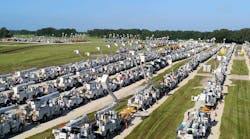Duke Energy is moving an extra 4000 field personnel from 23 states and Canada to the Carolinas in anticipation of Hurricane Dorian making its way up the Atlantic coast. The crews will complement the 5000 Duke Energy lineworkers and tree personnel in the Carolinas — creating a workforce of almost 9000 personnel.
Before power can be restored, crews first must assess the extent of damage — which can sometimes take 24 hours or more — to determine which crews, equipment, and supplies are needed before repairs can begin. Crews will also work to restore power while damage assessment occurs as conditions allow.
Customers should stay tuned to local news for the latest advisories from the National Weather Service and National Hurricane Center, as well as state and local emergency management officials.
"We will have a total field workforce of about 9000 ready to restore power when the storm moves out of the Carolinas," said Jason Hollifield, Duke Energy's incident commander for the Carolinas. "Our customers should know that once we begin work, we will not stop until restoration is complete."
To view a video of Hollifield discussing Hurricane Dorian, click here.
Safety Recommendations
Duke Energy urges customers to follow instructions and warnings issued by local emergency management officials before, during, and after a storm.
- Customers are advised to stay away from fallen or sagging power lines, and keep children and pets away from power lines as well. All power lines — including trees, limbs, or anything in contact with power lines — are to be considered energized and dangerous.
- Customers are requested to report all power line hazards using the following phone numbers:
- 800.769.3766 for Duke Energy Carolinas customers.
- 800.419.6356 for Duke Energy Progress customers.
- If a power line falls across a car they're in, customers should stay in the car. If they must get out of the car because of a fire or other immediate life-threatening situations, customers should do their best to jump clear of the car and land on both feet. No part of their bodies should be touching the car when their feet touch the ground.
- Prior to a storm, customers should create (or update) an emergency supply kit to save valuable time later. The kit should include everything an individual or family would need for at least two weeks, especially medicines and other supplies that might be hard to find after a storm strikes.
- Customers should review insurance policies and include extra copies of the policies, and other important documents in their emergency supply kits (ideally in a waterproof container).
- Customers should maintain a supply of water and nonperishable food.
- Customers should keep a portable radio, television, or NOAA weather radio on hand to monitor weather forecasts and important information from state and local officials.
- Customers should charge cellphones, computers, and other electronic devices in advance of the storm to stay connected to important safety and response information. Customers may also consider purchasing portable chargers and making sure they are fully charged.
- Customers should maintain a plan to move family members — especially those with special needs — to a safe, alternative location in case an extended power outage occurs or evacuation is required.
- Pet owners can make arrangements to stay at evacuation shelters that accept pets, at pet-friendly hotels, or friends' or family members' homes.
Tips on what to do before, during, and after a storm can be found here. For a hurricane kit checklist and important safety information, visit here.
How to Report Power Outages
Before the storm hits, customers should note how to report power outages. Customers who experience an outage during the storm can report it by:
- Visiting duke-energy.com on a desktop computer or mobile device.
- Texting OUT to 57801 (standard text and data charges may apply).
- Calling the automated outage-reporting system at 800.769.3766 for Duke Energy Carolinas customers and 800.419.6356 for Duke Energy Progress customers.
To read more about safety around power lines and for a video demonstration, visit here. For updates on Hurricane Dorian, visit here.


